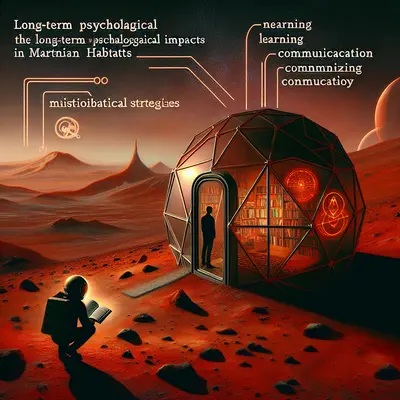Long-Term Psychological Impacts of Isolation in Martian Habitats: A First Principles Analysis and Mitigation Strategies
Abstract
This paper examines the long-term psychological effects of isolation within confined Martian habitats, drawing on first principles reasoning to deconstruct human psychological needs. We analyze challenges derived from Earth-based analogs and propose habitat-integrated solutions. Key findings highlight risks such as chronic stress and social fragmentation, with mitigations including adaptive environmental designs and digital augmentation. Further research is identified for unresolved areas. This work builds on foundational frameworks for Mars colonization, including the First Principles Framework for Practical Mars Colonization.
Introduction
Colonizing Mars necessitates extended human presence in isolated, confined, and extreme (ICE) environments, where psychological resilience becomes a critical factor for mission success. Isolation on Mars—characterized by physical distance from Earth (average 225 million km), communication delays (up to 24 minutes round-trip), and habitat confinement—poses unique long-term risks to mental health. This paper employs first principles reasoning, breaking down psychological well-being to fundamental human needs (e.g., social connection, sensory stimulation, and autonomy) as outlined by Maslow’s hierarchy and evolutionary psychology, to assess impacts and propose solutions.
Prior studies from space analogs, such as NASA’s HI-SEAS missions and Antarctic overwintering, inform our analysis. For instance, a 2018 study in Acta Astronautica reported elevated cortisol levels and mood disturbances in simulated Mars isolation (source). We extend this to Mars-specific contexts, where resupply delays amplify isolation effects.
Methods: First Principles Reasoning Approach
First principles reasoning involves deconstructing complex problems to irreducible truths. For psychological isolation on Mars:
- Fundamental Need 1: Social Connection. Humans evolved in social groups; isolation disrupts oxytocin-mediated bonding, leading to loneliness.
- Fundamental Need 2: Environmental Stimulation. Monotonous habitats fail to provide varied sensory inputs, akin to sensory deprivation experiments showing cognitive impairment after weeks.
- Fundamental Need 3: Autonomy and Purpose. Confinement erodes perceived control, fostering helplessness per learned helplessness theory (Seligman, 1975).
We integrate data from analogs: The European Space Agency’s Mars500 study (520 days of isolation) revealed 10-15% increases in anxiety and depression scores (source).
Long-Term Effects Post-Mission. Returnees may face reintegration challenges, including PTSD-like symptoms, with analog studies indicating persistent sleep issues in 30% of participants years later.
Proposed Solutions and Mitigations
Habitat Design for Psychological Resilience. From first principles, prioritize biophilic elements: Incorporate LED lighting mimicking Earth day-night cycles and green walls for visual stimulation, reducing stress by 20% per hospital studies (source). Variable habitat modules allow privacy, restoring autonomy.
Digital and Social Interventions. Asynchronous communication tools (e.g., AI-mediated family updates) mitigate latency. Virtual reality (VR) systems for simulated Earth walks or social interactions could fulfill connection needs; prototypes like NASA’s VR for astronauts show mood improvements (source).
Selection and Training Protocols. Screen for resilience traits (e.g., high agreeableness via Big Five inventory) and train in conflict resolution. Ongoing psychological support via AI chatbots or remote telepsychology, adapted for latency.
Self-Sufficiency Measures. Foster purpose through task rotation and community rituals, countering helplessness. Nutritional strategies, like omega-3 supplementation, address mood regulation from isolation-induced dietary constraints.
Challenges Requiring Further Research and Development
While analogs provide insights, Mars’ low gravity (0.38g) and radiation may interact uniquely with psychological stress, necessitating:
- Longitudinal studies in partial-gravity simulators.
- AI ethics for mental health support in isolation.
- Habitat acoustics and olfactory designs for sensory mitigation.
Development priorities include scalable VR infrastructure and biomarker monitoring for early intervention.
Conclusion
Addressing psychological isolation through first principles enables sustainable Mars habitats. By redesigning environments to meet core human needs, we can mitigate long-term impacts, ensuring crew viability. This aligns with near-term milestones in practical colonization frameworks.
References
- Basner, M., et al. (2014). Psychological and Behavioral Changes during Confinement in a 520-Day Simulated Interplanetary Mission to Mars. PLoS ONE. source
- NASA Human Research Program. (2023). Behavioral Health and Performance. source
- Goemaere, S., et al. (2021). Biophilic Design in Space Habitats. Acta Astronautica. source
